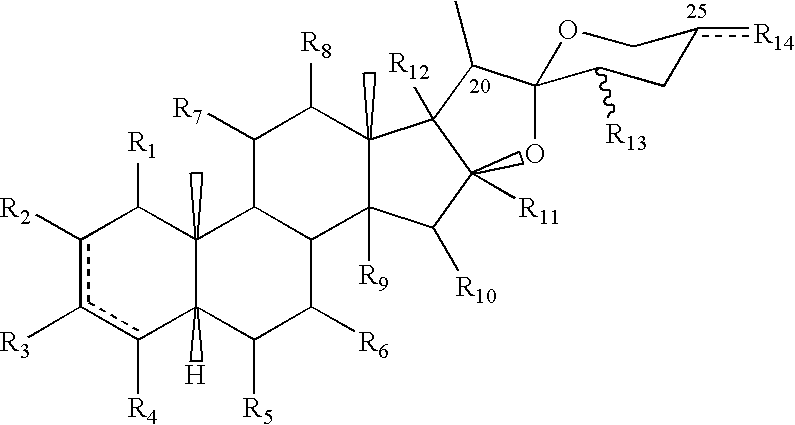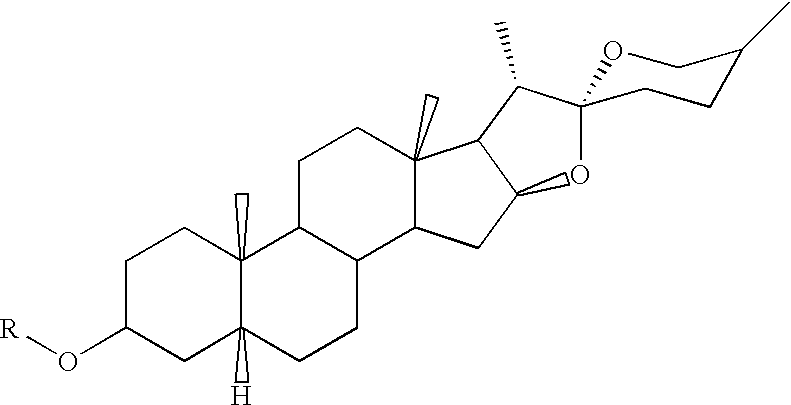Sapogenin derivatives, their synthesis and use, and methods based upon their use
a technology of saponin and derivatives, applied in the field of sapogenin, can solve the problems of saponins being less effective in crossing the blood-brain barrier, no relevant teaching can be discerned in documents,
- Summary
- Abstract
- Description
- Claims
- Application Information
AI Technical Summary
Benefits of technology
Problems solved by technology
Method used
Image
Examples
example 2
[0177] Alzheimer's Disease Model
[0178] An in vivo model of Alzheimer's disease was used in which amyloid beta and ibotenic acid are injected into the brain of the rat, which leads to a receptor loss in the brain and cognitive impairment Previous studies showed that local injection of amyloid .beta. in the nucleus vasalis of the rat brain caused cholinergic hypofunction and behavioural impairment up to two months post surgery (Giovannelli et al., 1995: Neuroscience, 6, 781-792.). In addition the co-injection of amyloid .beta. with a small amount of ibotenic acid into the rat hippocampus synergistically produces neuronal loss with infiltration of glial cells not only adjacent but also far from the injected site (Morimoto et al., 1998: Neuroscience, 84, 479-487).
[0179] Methods:
[0180] Our studies used the method of Morimoto (Morimoto et al., 1998: Neuroscience, 84, 479-487) with some modifications (unilateral instead of bilateral injection). Three months old, Sprague Dawley rats, were r...
example 3
[0200] Learning and Memory Test
[0201] Aged Sprague-Dawley rats aged were divided randomly into 4 groups, one control and groups treated for three months with either sarsasapogenin, episarsasapogenin cathylate or smilagenin (18 mg kg.sup.-1 day.sup.-1, n=10). A control group (n=14) of untreated young rats was also included in the study. The daily dose of drug was mixed in a minimum amount of food and was administered every morning separately to each rat.
[0202] A Y-maze apparatus was used for the learning and memory test. On the floor of each arm of the Y-maze is an array of copper rods to which electric current is applied whenever needed, with adjustable voltage. Each arm is 45 cm long and has a 15 W lamp at the end, which is turned on when needed. After 3 months drug administration, each rat was trained for 7 consecutive days, as follows. For each training session, the rat was put into one arm of the Y-maze, after two minutes rest, an electrical current was applied to the copper rod...
example 4
[0208] Neuroprotective Effect of Sarsasapogenin, Episarsasapogenin Cathylate and Smilagenin
[0209] The objective of this study was to examine the effects of sarsasapogenin, episarsasapogenin cathylate and smilagenin on the survival of rat primary cortical cultures treated with glutamate, which is known to induce neurodegeneration.
[0210] Primary Cultures of Cortical Neurons
[0211] Rat cortical neurons were cultured for 10 days; at day 10 the medium was changed to a serum-free defined medium. On day 12, 24 hours before glutamate exposure, cultures were washed and medium was replaced with fresh medium containing positive control (.beta.-oestradiol), test compounds (sarsasapogenin, episarsasapogenin cathylate or smilagenin) or vehicle control (DMSO, 0.25%).
[0212] On day 13, cultures were exposed to glutamate.
[0213] After the incubation period, the cultures were washed with and placed in fresh medium, supplemented with relevant compounds or vehicle to evaluate their protective effects, 24 ...
PUM
 Login to View More
Login to View More Abstract
Description
Claims
Application Information
 Login to View More
Login to View More - R&D
- Intellectual Property
- Life Sciences
- Materials
- Tech Scout
- Unparalleled Data Quality
- Higher Quality Content
- 60% Fewer Hallucinations
Browse by: Latest US Patents, China's latest patents, Technical Efficacy Thesaurus, Application Domain, Technology Topic, Popular Technical Reports.
© 2025 PatSnap. All rights reserved.Legal|Privacy policy|Modern Slavery Act Transparency Statement|Sitemap|About US| Contact US: help@patsnap.com



